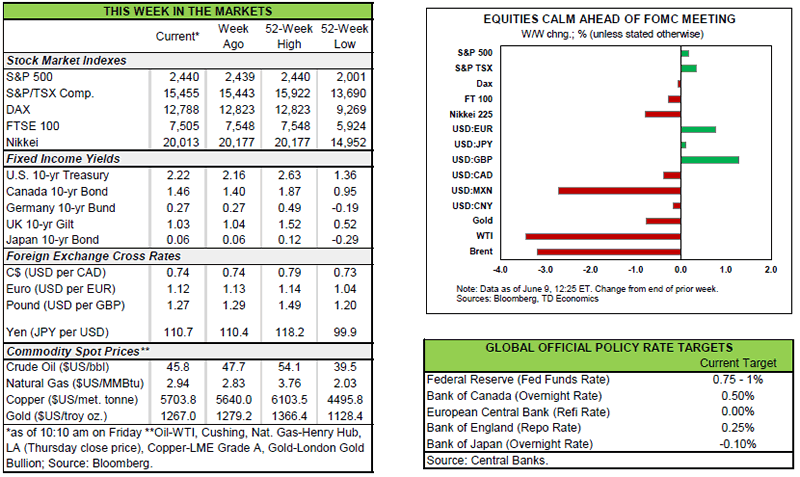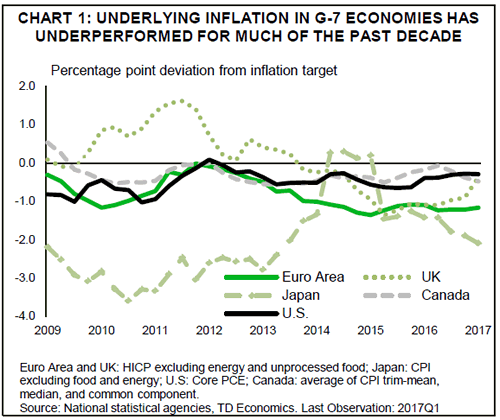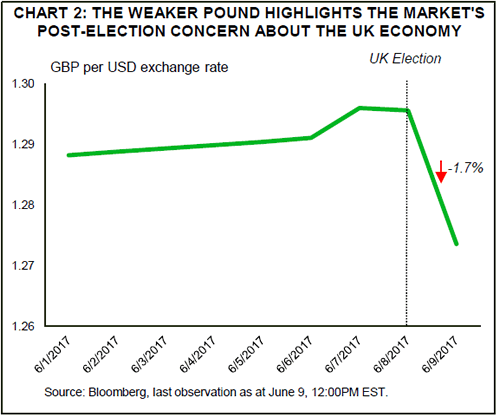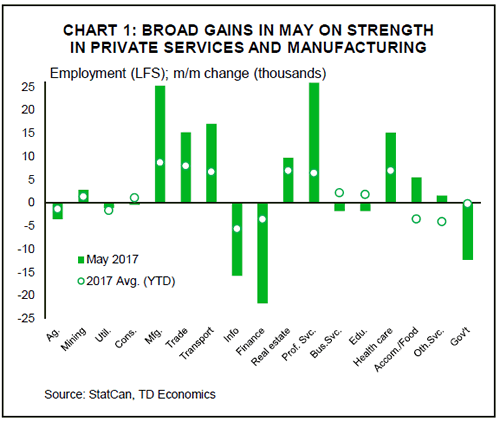HIGHLIGHTS OF THE WEEK
United States
- International events overshadowed domestic developments this week. Data on job openings and the non-manufacturing sector confirmed last Friday’s payroll report of slowing job growth, something that is to be expected at this point in the cycle.
- The ECB kept its monetary policy broadly unchanged, tilting its forward guidance slightly hawkish given the strong economic performance. However, downward revisions to its inflation forecasts suggests that the ECB is unlikely to join the Fed in tightening monetary policy anytime soon.
- The UK election has charged a shaky Conservative coalition government with negotiating Brexit. Although the election result serves to weaken the UK’s negotiating hand, it increases the likelihood that the UK maintains ties with the EU, favoring an arrangement similar to that between Norway and the EU.
Canada
- It was a relatively busy week in Canadian markets, with the loonie stumbling on the oil price drop midweek, before regaining some poise on robust economic data.
- Employment surged in May, with the economy adding 54.5 thousand jobs during the month. The gains were quite broad and all in full-time positions. Wages and hours remained weak but improved from previous months.
- Housing data pointed to resilience across most Canadian markets and a welcome cool-off in new and existing activity in Ontario. The Bank of Canada’s June FSR highlighted a growing concern about both household indebtedness and housing market imbalances, with a sharp correction in home prices in overheated markets flagged as a key risk for financial stability.

UNITED STATES – EUROPE ON THE MIND
Geopolitical events overshadowed domestic developments this week, although as typical of the new normal, financial markets remained relatively calm.
Following last Friday’s payrolls report, there was little economic news to stir U.S. risk or fixed income markets ahead of next week’s interest rate decision by the FOMC, in which it is widely expected to raise the federal funds rate by 25 bps. Both the job openings, turnover, and layoffs survey (JOLTS) for April and the ISM non-manufacturing survey for May were consistent with the message of slowing job growth from Friday’s payrolls report. This shouldn’t come as a surprise as employment growth tends to slow as the duration of an economic expansion lengthens.
Perhaps more insightful as to the health of the U.S. labor market are industry anecdotes and job openings data suggesting that the tight labor market is making it tougher for employers to find qualified help. Maybe this will provide the catalyst to ignite wage growth that has been subdued despite a tightening labor market, raising price pressures sufficiently for the FOMC to continue to normalize monetary policy with conviction.
Weak underlying inflation is a phenomenon that has been plaguing many advanced economies for the better part of the last decade, accented by overly optimistic forecasts from inflation-targeting central banks. At this week’s monetary policy meeting, the ECB left interest rates and monthly asset purchases unchanged, but tilted its forward guidance slightly more hawkish, a nod to the more balanced risks around the outlook for inflation given the strong economic performance of the Euro Area. Nonetheless, downward revisions to their inflation forecasts were widely interpreted by markets as dovish. A capitulation by the ECB, perhaps, to the fact that despite a rapid absorption of economic slack, underlying price growth will remain subdued over the next few years in the absence of significant wage pressures.
The ECB is right to remain dovish given the downside risks to the Euro Area outlook. Aside from the threat posed by a possible election of the anti-EU/euro M5S in Italy, perhaps a bigger threat to the region’s outlook is what may be a messy Brexit negotiation. Overnight we learned that the Conservative government’s gamble to ensure a strong majority in the UK parliament for the next four years failed. Instead, it appears that a shaky Conservative coalition government will negotiate exit terms with the EU, a result that only serves to further weaken their negotiating position, while raising policy uncertainty for businesses. On the bright side, this outcome increases the likelihood that the UK will maintain some existing ties with the EU, favoring an arrangement similar to that between Norway and the EU.
Lastly, this Sunday is the first of two rounds of French parliamentary elections. President Macron’s En Marche! party, supported by its Democratic Movement ally, is expected to earn a majority, giving the newly elected president a strong mandate to pursue a pro-business reform agenda aimed at improving the long-run growth performance of the French economy. The strength of his mandate will be known after the conclusion of next week’s second round ballot, but it appears that this election should deal another strong blow to French populism for the time being.


CANADA – ECONOMIC STARS ALIGNING FOR EARLY-2018 RATE HIKE
It was a relatively busy week in Canadian markets as investors digested fresh labour and housing market data and got an updated view from the Bank of Canada on the stability of the financial system. Equities and the loonie stumbled mid-week on a slump in oil prices related to a growing U.S. supply glut. But, Canadian markets recovered on solid economic numbers that painted a relatively healthy picture of the Canadian economy, and boosted the prospects for an earlier Bank of Canada rate hike. Markets are now pricing a one-third chance of a hike by year-end, with the odds of a move in the first quarter of 2018 better than even.
The renewed enthusiasm for the Canadian economy was highlighted by the strong employment numbers this morning. The Labour Force Survey indicated that 54,500 jobs were created across the country in May, with 77,000 full-time jobs added on the month. The May tally takes the twelve-month tally to 317,000, its fastest pace more than four years. Workers also flocked back into the labour force, which expanded by nearly eighty-thousand after a sizeable decline in the month prior, pushing the jobless rate up a tick to 6.6% in May. While P.E.I. registered the largest relative gain (+1,500), and is now leading the country in job growth at 4.7% y/y, most of the absolute gains were to be had in British Columbia (+12k), Quebec (+15k) and Ontario (+20k). Encouragingly, the job gains were relatively broad based, with manufacturing and most private services showing gains, while finance and construction had another weak month (Chart 1).
Softer finance and construction job numbers are in line with the cooling housing market. The pace of housing starts in May slowed to 194,000 annualized, down 20 thousand on the month and its slowest level in six months. All the weakness was in Ontario, where starts pulled back by 20 thousand after a 16 thousand drop in April (Chart 2), as developers digest the impact of the Fair Housing Plan introduced by the province on April 20th. In a complete reversal of the first-quarter story, the existing home market is also cooling. TREB figures released early this week pointed to a surge in new listings and decline in sales in May. Average transaction price dropped in the month, but this was more of a compositional effect given the skew towards condos. On the other hand, the quality-adjusted index increased slightly on the month, but decelerated to 29% from 31.6% year-on-year.
As outlined in our recent paper, this is a welcome cooloff for the red-hot market. The Bank of Canada’s updated Financial System Review highlighted growing concern about both household indebtedness and housing market imbalances, with a sharp correction in home prices in overheated markets flagged as a key risk for financial stability. Other key risks identified include a severe nationwide recession, a sharp increase in long term rates driven by higher global risk premiums, and stress emanating from emerging markets. These risks will remain top of mind for policy makers, but are unlikely to sway the Bank of Canada from proceeding with rate increases. All in all, while we don’t expect the Bank to move this year, an early-2018 hike is an increasingly likely scenario provided that economic data remains upbeat.















